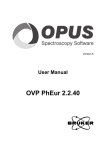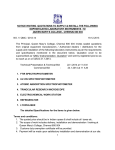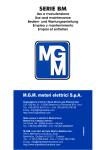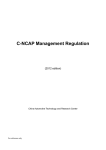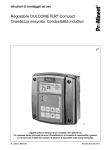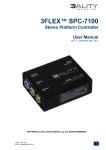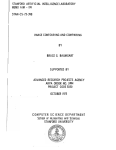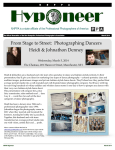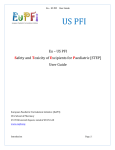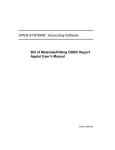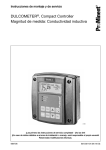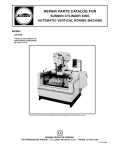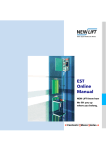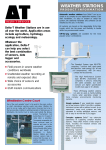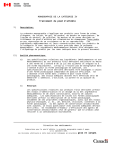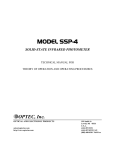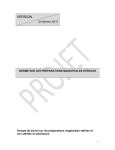Download OVP USP 1119
Transcript
Version 6 User Manual OVP USP 1119 © 2006 BRUKER OPTIK GmbH, Rudolf-Plank-Straße 27, D-76275 Ettlingen, www.brukeroptics.com All rights reserved. No part of this manual may be reproduced or transmitted in any form or by any means including printing, photocopying, microfilm, electronic systems etc. without our prior written permission. Brand names, registered trademarks etc. used in this manual, even if not explicitly marked as such, are not to be considered unprotected by trademarks law. They are the property of their respective owner. The following publication has been worked out with utmost care. However, Bruker Optik GmbH does not accept any liability for the correctness of the information. Bruker Optik GmbH reserves the right to make changes to the products described in this manual without notice. This manual is the original documentation for the OPUS spectroscopic software. Table of Contents 1 Introduction . . . . . . . . . . . . . . . . . . . . . . . . . . . . . . . . . . . . . . . . . . . . . . .1 1.1 2 Test Setup . . . . . . . . . . . . . . . . . . . . . . . . . . . . . . . . . . . . . . . . . . . . . . . . .3 2.1 2.2 2.3 2.4 3 Reference Standards . . . . . . . . . . . . . . . . . . . . . . . . . . . . . . . . . . . . . . . . . . . . 3 Setting up OVP for USP 1119 . . . . . . . . . . . . . . . . . . . . . . . . . . . . . . . . . . . . 5 Reflection Measurement Mode . . . . . . . . . . . . . . . . . . . . . . . . . . . . . . . . . . . 10 2.3.1 Photometric Linearity Test . . . . . . . . . . . . . . . . . . . . . . . . . . . . . . . 10 2.3.2 Photometric Noise Test . . . . . . . . . . . . . . . . . . . . . . . . . . . . . . . . . 13 2.3.3 Wavelength Uncertainty Test . . . . . . . . . . . . . . . . . . . . . . . . . . . . . 14 Transmission Measurement Mode . . . . . . . . . . . . . . . . . . . . . . . . . . . . . . . . 16 2.4.1 Photometric Linearity Test . . . . . . . . . . . . . . . . . . . . . . . . . . . . . . . 16 2.4.2 Photometric Noise Test . . . . . . . . . . . . . . . . . . . . . . . . . . . . . . . . . 18 2.4.3 Wavelength Uncertainty Test . . . . . . . . . . . . . . . . . . . . . . . . . . . . . 19 Run OVP Tests . . . . . . . . . . . . . . . . . . . . . . . . . . . . . . . . . . . . . . . . . . . .23 3.1 3.2 3.3 3.4 4 USP 1119 NIR Instrument Specifications . . . . . . . . . . . . . . . . . . . . . . . . . . . 1 Photometric Linearity Test . . . . . . . . . . . . . . . . . . . . . . . . . . . . . . . . . . . . . . 25 3.1.1 Reflection Measurement . . . . . . . . . . . . . . . . . . . . . . . . . . . . . . . . . 25 3.1.2 Transmission Measurement . . . . . . . . . . . . . . . . . . . . . . . . . . . . . . 25 Photometric Noise Test . . . . . . . . . . . . . . . . . . . . . . . . . . . . . . . . . . . . . . . . . 26 3.2.1 Reflection Measurement . . . . . . . . . . . . . . . . . . . . . . . . . . . . . . . . . 26 3.2.2 Transmission Measurement . . . . . . . . . . . . . . . . . . . . . . . . . . . . . . 26 Wavelength Uncertainty Test . . . . . . . . . . . . . . . . . . . . . . . . . . . . . . . . . . . . 27 3.3.1 Reflection Measurement . . . . . . . . . . . . . . . . . . . . . . . . . . . . . . . . . 27 3.3.2 Transmission Measurement . . . . . . . . . . . . . . . . . . . . . . . . . . . . . . 27 Printing Reports . . . . . . . . . . . . . . . . . . . . . . . . . . . . . . . . . . . . . . . . . . . . . . 28 Appendix - Wavelength Uncertainty Test using Water Vapor . . . . .29 4.1 4.2 4.3 4.4 4.5 4.6 4.7 4.8 4.9 References . . . . . . . . . . . . . . . . . . . . . . . . . . . . . . . . . . . . . . . . . . . . . . . . . . . 29 Document History . . . . . . . . . . . . . . . . . . . . . . . . . . . . . . . . . . . . . . . . . . . . . 30 Introduction . . . . . . . . . . . . . . . . . . . . . . . . . . . . . . . . . . . . . . . . . . . . . . . . . . 30 Purpose . . . . . . . . . . . . . . . . . . . . . . . . . . . . . . . . . . . . . . . . . . . . . . . . . . . . . 30 USP Requirements . . . . . . . . . . . . . . . . . . . . . . . . . . . . . . . . . . . . . . . . . . . . 30 Spectra Comparison of SRM 2035 and Water Vapor . . . . . . . . . . . . . . . . . 31 Reference for Water Vapor Absorbance . . . . . . . . . . . . . . . . . . . . . . . . . . . . 34 Connes’ Advantage of Fourier Transform Interferometry . . . . . . . . . . . . . . 36 Conclusion . . . . . . . . . . . . . . . . . . . . . . . . . . . . . . . . . . . . . . . . . . . . . . . . . . 36 iii USP 1119 NIR Instrument Specifications 1 Introduction This manual describes the OPUS Validation Program (OVP) for spectrometer qualification according to the guidelines set forth by the U.S. pharmacopoeial forum, chapter 1119. The three OQ (Operation Qualification) test protocols check the instrument performance and compares this performance to the instrument specifications. These tests include: • Photometric Linearity • Photometric Noise • Wavelength Uncertainty These tests are only designed for NIR spectrometers. Refer to U.S. pharmacopoeial forum, chapter 1119, for additional information about these testing methods. Note: The USP 1119 test is primarily used for OQ (Operational Qualification) testing. The high flux noise test only is recommended to be run for PQ (Performance Qualification). Thus, we recommend to set up the complete test protocol for OQ, except for the high flux noise test. 1.1 USP 1119 NIR Instrument Specifications Photometric Linearity AOBS VS AREF at 1200, 1600, 2000nma (8333, 6250, 5000cm-1) Slope = 1.0 ± 0.05; Intercept = 0.0 ± 0.05 Photometric Noise Measured for 100nm (300cm-1) segments between 1200 and 2200nm (8300 and 4500cm-1) Average RMS for High Flux Measurements less than 0.3 x 10-3; no RMS noise greater than 0.8 x 10-3 Average RMS for Low Flux Measurements less than 1 x 10-3; no RMS noise greater than 2.0 x 10-3 Bruker Optik GmbH OVP for USP 1119 1 Introduction Wavelength Uncertainty Tolerances SRM 1920a peaksb occurring at 1261, 1681, 1935nm ± 1nm at 1200nm or ± 8cm-1 at 8300cm-1 ± 1nm at 1600nm or ± 4cm-1 at 6250cm-1 ± 1nm at 2000nm or ± 4cm-1 at 5000cm-1 a. AOBS is the observed absorbance and AREF is the tabulated absorbance of the reference reflectors at each of the three specified wavelengths. b. The nominal 1935nm peak is sensitive to instrument bandwidth. Use the wavelength value supplied with SRM 1920a at the appropriate instrument bandwidth to determine wavelength. 2 OVP for USP 1119 Bruker Optik GmbH Reference Standards 2 Test Setup OVP USP 1119 supports reflectance channels as well as transmittance channels. Depending on the specified measurement channel OVP USP 1119 detects the proper configuration automatically. If you select a reflectance channel, only the tests for reflectance measurements will be activated. If you select a transmission channel, only the tests for transmission measurements will be activated. In case of fiber optics ports you can select between reflectance and transmission mode, depending on the type of probe connected to the fiber port. Once selected, the mode cannot be changed later. Depending on the spectrometer type and test mode additional external reference standards may be required. The following table shows instrument types, test modes and standards which are used for the different tests. Before setting up the tests make sure that the required standards are available. 2.1 Reference Standards Photometric Linearity Test: Instrument Type MPA MATRIX VECTOR 22/N Test Mode External Standard None Gold Standard (for straylight correction spectra only) Labsphere Standard Set with 99% (Reference), 80%, 40%, 20%, 10% optional (1): 5% optional (2): 60%, 5%, 2% MPA with BRM 2065 Transmission and Glass filters NG4, NG9 and NG11 Filter NG4 Filter NG9 Filter NG11 None MPA, MATRIX, Transmission VECTOR 22/N with Polystyrene and Glass filter NG4 and NG9 Filter NG4 Filter NG9 Filter NG11 Bruker Optik GmbH Reflection Internal Standard OVP for USP 1119 3 Test Setup High Flux and Low Flux Noise Test: Instrument Type Test Mode Internal Standard External Standard MPA MATRIX VECTOR 22/N Reflection None Labsphere Standards 99% and 10% MPA, MATRIX, VECTOR 22/N Transmission Filter NG9 Spectralon None Wavelength Uncertainty and Wavelength Reproducibility Test: Note: This test requires only a single standard - if standards are listed in both the internal and external standard column, you can either use the internal or external standard. Alternatively, you can use water vapor (which is not listed in the table) instead of reference standards for both reflection and transmission mode. Details are given in the attachment. Instrument Type MPA MATRIX VECTOR 22/N Test Mode Reflection Internal Standard None External Standard Gold Standard or Labsphere 99% for reference measurement SRM 1920a or KTA 1920x or SRM 2036 4 MPA with BRM 2065 Transmission and Glass filters NG4, NG9 and NG11 BRM 2065 SRM 2065 or SRM 2035 or BRM 2065 MPA, MATRIX, Transmission VECTOR 22/N with Polystyrene and Glass filter NG4 and NG9 None SRM 2065 or SRM 2035 or BRM 2065 OVP for USP 1119 Bruker Optik GmbH Setting up OVP for USP 1119 2.2 Setting up OVP for USP 1119 If you have already setup OVP for OQ and/or PQ (Performance Qualification)1, you can skip this chapter. Before you can use OVP for USP 1119 you have to set up the corresponding USP 1119 parameters and define the OVP test channels and OVP tests. Select the OVP Setup command from the Validation menu to open the following dialog: Figure 1: Setup OVP Enter a title for the current configuration into the Title for new configuration entry field, to specify the current setup by a descriptive text. 1. Short-term test which evaluates the spectrometer performance and proper spectrometer. Bruker Optik GmbH OVP for USP 1119 5 Test Setup Click on the Add new configuration button. Now, all the other selection fields will no longer be hidden and can be filled in. A B C D G E F H I Figure 2: Setup OVP - Activated drop-down lists A) The drop-down list shows the test channel used by OVP. B) For each spectrometer test channel you have to assign a measurement configuration to be used during actual validation measurement. This is a valid combination of source, beam splitter, measurement channel and detector. As soon as you have selected all components the appropriate instrument configuration (C) and the bitmap (E) specified for the measurement channel will automatically be displayed. C) In general, the instrument configuration is automatically displayed as soon as you have selected all components. Always check whether the correct instrument configuration has been suggested. If required, select a different instrument configuration. D) Depending on the test channel, the drop-down list contains appropriate accessories. E) Depending on the measurement channel selected a configuration-specific bitmap will be displayed. F) Use the Load Image button to load further instrument images available in OPUS. The bitmaps are stored in the OPUS\VALIDATION\Bitmaps directory. Select the Thumbnail option from the pop-up menu when clicking on the button to be able to see at once which bitmap belongs to which file name. For details on the bitmaps refer to the OPUS Reference Manual, chapter 13. You can also make your own photo with a size of 90 x 90 and store it into the bitmap directory using the ITnn.bmp file name (nn is a consecutive number). 6 OVP for USP 1119 Bruker Optik GmbH Setting up OVP for USP 1119 G) To delete the current configuration click on this button. Once deleted the settings cannot be reloaded. If you have accidentally deleted a channel, you have to repeat the complete setup again. OVP configurations are stored in the OPUS\VALIDATION\Database\<Instrument> directory. H) To save the configuration click on the Save and Exit button. I) Click on this button to interrupt the setup without saving. Figure 3: Setup OVP - Bitmap of instrument type Bruker Optik GmbH OVP for USP 1119 7 Test Setup If you click on the OVP Test Setup tab, the following dialog opens: Figure 4: OVP Test Setup tab The line on the very top shows the test channel selected on the OVP Test Channel Setup tab. If you activate the Run check box on the OVP Test Setup tab, the following line will be displayed: 8 OVP for USP 1119 Bruker Optik GmbH Setting up OVP for USP 1119 Figure 5: Configuring USP 1119 test Select USP1119 from the first drop-down list and the OQ test category from the second. If the OQ test has not been setup, make sure that the expiration time for the test is properly defined in the OQ line. Type the interval period into the entry field and select the units from the drop-down list. Available units are hours, days, or months. Click on the Setup button to open the USP1119 Setup dialog. If all tests have been set up and you click on the OK button, the setup status is indicated by a green check mark. Bruker Optik GmbH OVP for USP 1119 9 Test Setup 2.3 Reflection Measurement Mode Figure 6: USP 1119 Test Protocol - Test setup for reflection First, define the correct type of measurement, i.e. either reflection or transmission. Activate the corresponding option button. Figure 6 shows the setup dialog for reflection measurement. Initially, all tests are selected in the Test Selection group field. When using a configuration with an integrating sphere the test channel for OVP will normally be set up with the internal reference position (e.g. Sphere Background for the MPA). As this kind of setting cannot be used for USP tests you have to select the actual measurement channel from the drop-down list. To perform all three tests make sure that all test options are selected. There is a separate page for each test selected. Note that at least one test has to be selected. 2.3.1 Photometric Linearity Test The photometric linearity test is performed using a set of reflectance standards of known relative reflectance. This test has been optimized for use with the LabsphereTM brand of NIR reflectance standards. 10 OVP for USP 1119 Bruker Optik GmbH Reflection Measurement Mode According to USP 1119, the spectra obtained from reflectance standards are subject to variability due to the difference between the experiment conditions under which they are factory-calibrated and those under which they are subsequently used. Hence, the percent reflectance values supplied with the calibration certificate may not be useful to establish an absolute calibration for a given instrument. However, as long as the standards have the same physical description, the same reference background is used, and the target instrument measures each under identical settings, the reproducibility of the photometric scale will be established over the range of standards used. Subsequent measurements give information on long-term stability. The photometric linearity test requires a set of certified reflectance standards with known reflectance values. USP 1119 requires one standard (99%) for reference and at least four standards for the test itself (80%, 40%, 20% and 10%). When measuring samples of low reflectance an additional low reflecting standard (5%) is required. Enter the data for the certification table. These data are listed in tables in the calibration certificate, or are provided in digital form on a CD or diskette. Click on the Photometric Linearity tab to open the following dialog: B A C D E F G Figure 7: USP 1119 Test Protocol - Photometric Linearity tab Bruker Optik GmbH OVP for USP 1119 11 Test Setup A) If you click on this button, a load dialog opens. Load the standard settings data file which allows to read the certificate values from a text file which is normally delivered with the set, provided the set was purchased from Bruker. Table F and the drop-down lists B and C correlate to the file data. B) Enter the report number to identify a set of standards. The report number is listed in the certificate. C) Enter the date of calibration to identify a set of standards. The date of calibration is listed in the certificate. If you click on the arrow key, a small calendar view pops up. D) Select the number of standards to be measured for the test (excluding the 99% reference standard). E) Depending on the number of standard selected the table displays only those columns for which an entry is required. F) You have to enter both the values for the three specified frequencies and two values left and two values right from these frequencies. G) Activate this check box if a stray light correction has to be done prior to the evaluation of test spectra. If you measure by using an integrating sphere, it is essential to use the stray light correction for this test. For details about the stray light correction and how to record the correction spectra refer to the OPUS Reference Manual. Some hints for data entry We highly recommend to use a text file for data input. If such a file has not been supplied, generate such a file. For details see chapter 4. Figure 8: Text file example for data input 12 OVP for USP 1119 Bruker Optik GmbH Reflection Measurement Mode • You do not need to add factors for every column of reflection standard, only enter the data for standards you will be using. • You have to enter a value for every frequency in the table. • You have to navigate by using the mouse as the Tab and Enter keys cannot be used. 2.3.2 Photometric Noise Test The photometric noise test involves measuring spectra of high and low light throughput which is achieved by using high and low reflectance material. The analysis is performed by measuring the root-mean-square (RMS) noise level in successive 100nm (300cm-1) spectral segments, between 1200 and 2200nm (8300 and 4500cm-1). Depending on the measurement channel a different frequency range may be used. The High Light Flux measurement uses the LabsphereTM 99% (SRS-99-010) standard. The Low Light Flux measurement uses the LabsphereTM 10% (SRS-10-010) standard. This measures system performance at reduced light level. Noise from the source, detector, optics, and electronics make significant contributions at this level. A B C Figure 9: USP 1119 Test Protocol - Photometric Noise tab Bruker Optik GmbH OVP for USP 1119 13 Test Setup A) Activate this check box if you want to perform the High Flux Noise measurement. B) Activate this check box if you want to select the Low Flux Noise measurement. C) The measurement range used for the specified channel. The range is recommended by USP 1119 but may be different if the instrument does not support this range. 2.3.3 Wavelength Uncertainty Test In case of the wavelength uncertainty test you can choose between two test methods. The USP 1119 method requires the use of a certified reference standard like NIST 1920a, NIST SRM 2065 or KTA 1920x. The background measurement is performed by either using a gold standard or the 99% Labsphere standard, and then the standard is measured. The specific peaks for the reflectance standards are measured with their values determined using the center of gravity algorithm. This test also provides information for long-term system stability. The band frequencies are listed in the Certificate of Analysis provided with the reference standard. Some certificates list frequencies for a different resolution. Make sure that you choose the frequency values from the column with the resolution (4cm-1) specified. A B C D E Figure 10: USP 1119 Test Protocol - Wavelength Uncertainty test 14 OVP for USP 1119 Bruker Optik GmbH Reflection Measurement Mode A) Select the standard to be used for the test. When using water vapor B to E will not be visible. B) Select the standard to be used from the drop-down list. C) This line shows the recommended frequencies to be used for evaluation. Chose bands from the certificate which are closer to these frequencies. D) The three entry fields allow to enter the bands as provided in the Certificate of Analysis. E) Depending on the standard the frequencies in the certificate can be listed in nanometers or wavenumbers. Thus, the values can either be entered in nanometers or as wavenumbers. Select the required units by activating the respective option button. The alternative method measures a specific peak of water vapor. This has the advantage of not requiring a reflectance standard and also grants a much higher precision. The appendix describes the advantages of using water vapor for this test. A Figure 11: USP 1119 Test Protocol - Wavelength Uncertainty test A) Activating the Use Water Vapor option button measures the specific water vapor peak at 7306.736cm-1, using the standard peak-picking algorithm. Bruker Optik GmbH OVP for USP 1119 15 Test Setup 2.4 Transmission Measurement Mode Figure 12: USP 1119 Test Protocol - Test setup for transmission The test setup for the transmission mode is very similar to the one for reflection mode. Initially all tests are selected. The Test Selection group field contains all tests available for transmission measurement. To perform all three tests, select all the test options. There is a separate page for each test selected. Note that at least one test has to be selected. 2.4.1 Photometric Linearity Test The photometric linearity test is performed using the open channel and three different glass filters which are mounted on the internal validation unit (IVU) of your spectrometer. Currently no external certified transmission standards with known transmission values are available. Similar to the reflectance measurements the evaluation uses three different frequencies over the measurement range. The frequencies have been selected with respect to the filter material which does not provide a linear transmission over the full range. The open channel and three filters have to be measured to cover an as large as possible range of transmission values. 16 OVP for USP 1119 Bruker Optik GmbH Transmission Measurement Mode According to USP 1119 the measurements are not possible to establish an absolute calibration for a given instrument. However, as long as the standards have the same physical description, the same reference background is used, and the target instrument measures each under identical settings, the reproducibility of the photometric scale will be established over the range of standards used. Subsequent measurements give information on long-term stability. To set up a photometric linearity test you have to measure reference values before you can run the test. Reference measurements should only be repeated after replacement of optical components or major repair. NOTE: In case of instruments without the internal NG11 glass filter you will be asked during the reference measurement to insert the external NG11 standard which is available at Bruker. A B C D Figure 13: USP 1119 Test Protocol - Photometric Linearity tab A) The Filter Setting column shows the filters used for testing. The filters are automatically determined by the program B) The values for the reference measurement are displayed in the table. C) Click on this button to measure the reference spectra. D) These lines show if and when the last reference has been measured. In the latter case the date and time of the measurement is also displayed. These lines also show whether a reference measurement is in progress. Bruker Optik GmbH OVP for USP 1119 17 Test Setup The transmission data are retrieved from the spectra and filled in the grid. Typical filter spectra and the frequencies used for evaluation are shown in figure 14. Figure 14: Typical filter spectra 2.4.2 Photometric Noise Test The photometric noise test involves measuring spectra using the open channel and one of the glass filters on the IVU as low-transmission material. The analysis is performed by tabulating the root-mean-square (RMS) noise level in successive 100nm (300cm-1) spectral segments between 1200 and 2200nm (8300 and 4500cm-1) and the average of these values. Depending on the measurement channel a different frequency range may be used. The High Flux Noise measurement uses the open channel. The Low Flux Noise measurement uses the glass filter NG9 or the internal Spectralon. This measures system performance at reduced light levels. Noise from the source, detector, optics, and electronics make significant contributions at this level. If one of the tests is not available for a certain instrument configuration, this test will be disabled. 18 OVP for USP 1119 Bruker Optik GmbH Transmission Measurement Mode A B C Figure 15: USP 1119 Test Protocol - Photometric Noise tab A) Activate this check box if you want to perform the High Flux Noise measurement. B) Activate this check box if you want to perform the Low Flux Noise measurement. C) The measurement range used for the specified channel. The range is recommended by USP 1119 but may be different if the instrument channel does not support this range. 2.4.3 Wavelength Uncertainty Test The USP 1119 method requires the use of a certified reference standard. The Wavelength Uncertainty test has a choice of one of two test methods. The method recommended by Bruker measures a specific peak of water vapor. This has the advantage of not requiring a transmission standard and also grants a much higher precision. The appendix describes the advantages of using water vapor for this test. Bruker Optik GmbH OVP for USP 1119 19 Test Setup A B Figure 16: USP 1119 Test Protocol - Wavelength Uncertainty test A) Activating the Use Water Vapor option button measures a water vapor peak using the standard peak-picking algorithm. B) The specific water vapor peak is measured at 7306.736cm-1. External standards like NIST SRM 2065, SRM 2035 can be purchased and used as well. Bruker offers the BRM 2065 reference standard which is mounted on the IVU and which allows to run all tests fully automatically. A certificate for this standard is available. Note: For instruments without the internal BRM 2065 an external transmission standard (BRM 2065 or SRM 2065) is required if you want to use a standard. This standard is available from Bruker. First, a background measurement is performed. Then, the standard is measured. The specific frequency peaks for the reflectance standards are measured with their values determined using the center of gravity algorithm. This test also provides information for long-term system stability. The band frequencies are listed in the Certificate of Analysis provided with the reference standard. Make sure that you select the frequency values from the column with the specified resolution of 4cm-1. Recommended band frequencies vary for different standards and are shown on the Wavelength Uncertainty page. Thus, before entering the reference values from the certificate make sure the proper reference standard has been selected from the standards drop-down list. 20 OVP for USP 1119 Bruker Optik GmbH Transmission Measurement Mode A B C D E Figure 17: USP 1119 Test Protocol - Wavelength Uncertainty test A) Select the standard to be used for the test. When selecting the internal or external reference standard using water vapor B to E will not be visible. B) Select the standard to be used from the drop-down list. C) This line shows the recommended peaks to be used for evaluation. First, select the standard as described in A. D) Three entry fields are provided to enter the peak frequencies as provided in the Certificate of Analysis. E) Depending on the standard the frequencies in the certificate can be listed in nanometers or wavenumbers. The values can thus either be entered in nanometers or as wavenumbers. Select the required units by activating the respective option button. If you use an internal standard and in case of instruments previously designed, the standard data are read from the instrument and entered automatically. In this case you cannot enter any data into the entry fields. Additionally, a temperature control of the band position is automatically performed in the subsequent test. Bruker Optik GmbH OVP for USP 1119 21 Test Setup 22 OVP for USP 1119 Bruker Optik GmbH 3 Run OVP Tests There are two possibilities to run OVP tests. Either by selecting the Run OVP Tests command in the Validation menu or by clicking on the status light ( ) and using the Instrument Status dialog. For details on the letter case refer to the OPUS Reference Manual, chapter 13. To start running the tests click on the Run OVP Tests command in the Validation menu. The following dialog opens: Figure 18: Run OVP Tests Bruker Optik GmbH OVP for USP 1119 23 Run OVP Tests The IT n drop-down list allows to select the appropriate IT test channel. The lines below show the tests set up for the IT test channel selected, as well as the test status. Tests which have expired, or which have not yet been performed are automatically activated for measurement. Tests which interval has not yet expired are not activated, and their remaining time is indicated as a reminder. If a test has not expired, but the interval has only e.g. 2 hours left you can activate the check box for that test and run the test earlier. If a test has expired, but you are not prepared to perform that test (external standards required), you can deactivate the check box for the corresponding test. Figure 19: OVP test status As soon as you have activated the check box for the respective test protocol you can see which test(s) will be performed by the browser-like display next to the bitmap. All measurement results are stored in a report (PDF file) and in the UserData database. To append a comment to the current test protocol entry write a comment into the User Comment entry field. Click on the Run selected Tests button to start the respective tests. If you do not want to perform any test, click on the Cancel button. 24 OVP for USP 1119 Bruker Optik GmbH Photometric Linearity Test 3.1 Photometric Linearity Test 3.1.1 Reflection Measurement Prerequisites: • The photometric linearity test for reflection measurements requires the use of the 99% reflectance standard (SRS-99-010) for reference (background) measurement. • For an integrating sphere the straylight correction spectra must have been measured using a Bruker certified gold standard with the certified reflection factor entered to measure the straylight correction spectra. • For an integrating sphere the straylight correction check box in the USP 1119 Setup has to be set and the proper channel selected. • For an integrating sphere a special 8 degree sample holder has to be used. • For a fiber solid probe the straylight correction must not be used. In this case also use an appropriate sample holder. Follow the wizard instructions. Note: The measurement requires specialized holders for the reference standards. After the reference measurement has completed, you will be prompted for each of the reflectance standards selected in the USP 1119 Setup dialog. Insert each standard into the sample holder as requested, and follow the instructions to perform the measurements. If each of the standards has been measured, the final results will be computed. 3.1.2 Transmission Measurement Prerequisites: The Photometric Linearity test for transmission measurements uses the glass filters mounted on the IVU (Internal Validation Unit). The test itself runs fully automatically and needs no user interaction. • For instruments with only two glass filters on the IVU an external NG 11 glass filter is required. Bruker Optik GmbH OVP for USP 1119 25 Run OVP Tests 3.2 Photometric Noise Test 3.2.1 Reflection Measurement Prerequisites: • The Photometric High Light Flux Noise test for reflection measurements requires the Labsphere 99% reflectance standard (SRS-99010). • The Photometric Low Light Flux Noise test for reflectance measurements requires the Labsphere 10% reflectance standard (SRS-10010). • For an integrating sphere a special 8 degree sample holder must be used. Follow the wizard instructions. Note: The measurement requires specialized holders for the reference standards. For each test (High or Low Light Flux) a reference and sample measurement are performed using the reflectance standard. At the end of the test the final results are computed. 3.2.2 Transmission Measurement Prerequisites: • None The photometric noise test for transmission measurements is performed by using the open channel and a filter on the IVU. The test itself runs fully automatically and needs no user interaction. 26 OVP for USP 1119 Bruker Optik GmbH Wavelength Uncertainty Test 3.3 Wavelength Uncertainty Test 3.3.1 Reflection Measurement Prerequisites: • The wavelength uncertainty test for reflection measurements requires the use of either the 99% reflectance standard (SRS-99-010) or a gold standard for the reference (background) measurement. • Unless water vapor is used for these tests an external certified reference standard (see table in chapter 2.1) is required for the sample measurement. The reference measurement for this test can be performed using the standard method used for your spectrometer and configuration (e.g. gold standard for integrating sphere, reference position for fiber optics solid probe etc.). Instead of the gold standard, the 99% Labsphere Reference standard can be used as well. Follow the wizard instructions. Note: This may require specialized holders for the reference standard. At the end of the test the final results will be computed. 3.3.2 Transmission Measurement Prerequisites: • In case of transmission measurements the reference (background) measurement for the wavelength uncertainty test is run with the open channel. • Unless water vapor is used for this test either an external certified reference standard (see table in chapter 2.1) or the internal reference standard (BRM 2065) on the IVU with certificate is required for the sample measurement. You will be prompted for the standard to be inserted into the sample holder only if an external reference standard has been selected. Note: This may require specialized holders for the reference standard. If the internal BRM 2065 standard or water vapor has been selected, the test will run without any further user interaction. Bruker Optik GmbH OVP for USP 1119 27 Run OVP Tests 3.4 Printing Reports The results of test measurements are stored in a report (PDF format). The test report contains a summarized test result page and subsequent pages for each test with all the test spectra displayed. Reports are stored in the separate VALIDATION\REPORTS directory and can automatically be displayed and/or printed. To have the report displayed and printed you require the Adobe Acrobat Reader which is available on the OPUS installation CD. 28 OVP for USP 1119 Bruker Optik GmbH References 4 Appendix - Wavelength Uncertainty Test using Water Vapor 4.1 References [1]Second Supplement, USP-NF <1119> Near-Infrared Spectrophotometry [2]H2O vapor calibration-engl.doc, Dr. Axel Keens, 31 May 2001 [3]2035.pdf, National Institute of Standards & Technology, Certificate, Standard Reference Material® 2035 [4]C. Kradjel, U. Grummisch, R. Rachlis, in: "Making Light Work: Advantages in Near Infrared Spectroscopy", Developed from the 4th International Conference on Near Infrared Spectroscopy, Aberdeen, Scotland, August 19-23, 1991; edited by I. Murray and I.A. Cowe, VCH Weinheim, 1992, Page 470. [5]H. Günzler, H.M. Heise, "IR-Spektroskopie, Eine Einführung"; 3. Auflage, VCH Weinheim, 1996, Seite 84. [6]J. Gronholz, W. Herres, "Understanding FT-IR Data Processing", I&C, Dr. Alfred Huethig Publishers, 1984, Page 2. [7]H. Gremlich, Infrared and Raman Spectroscopy Encyclopedia of Industrial Chemistry, 1994, VCH. (§2.1),Ullmann's [8]P. Griffiths, Fourier Transform Infrared Spectrometry (§1 VII), 1986, Wiley, ISBN 0-471-09902-3 Bruker Optik GmbH OVP for USP 1119 29 Appendix - Wavelength Uncertainty Test using Water Vapor 4.2 ISSUE Document History DATE REVISION 1 10/09/2002 4.3 AUTHOR Andrea Giehl Description File name Wavelength uncerWavelength tainty test for Bruker accuracy.doc FT-NIR spectrometer Introduction Wavelength uncertainty test is part of the instrumental tests needed for the qualification of an NIR spectrometer in accordance with: • USP Pharmacopoeia Forum <1119> 26(2000) 237-247 • Ph. Eur. III, 2.2.40 Near-Infrared Spectrometry, 43-44 This test is to ensure that the measured wavelengths are accurate and remain accurate for measurements in diffuse reflectance or transmittance mode. 4.4 Purpose The purpose of this document is to provide detailed information on the use of water vapor absorbance bands for the calibration and validation of Fourier Transform NIR spectrometers. Measuring the water vapor absorbance band at a single wavenumber shall replace the wavelength uncertainty test of Michelsontype FT-NIR spectrometers required by USP, for both diffuse reflection and transmission measurements. NOTE: wavenumber = 1/wavelength 4.5 USP Requirements In [1] the regulations are set for the Instrument Operational Qualification with regards to Wavelength Uncertainty. They are as follows: Wavelength Uncertainty: [Note: The method used in developing wavelength uncertainty values is based on the NIST Center of Gravity algorithm.] Potential problems with internal calibration schemes are avoided by specifying appropriate independent external wavelength standards. For the reflectance mode, the NIST SRM 1920a reflectance standard is preferred. Standards containing dysprosium or holmium oxide are available. The nature and type of 30 OVP for USP 1119 Bruker Optik GmbH Spectra Comparison of SRM 2035 and Water Vapor background reference standard must also be specified. In transmittance measurements, the corresponding rare earth solution1 or glass standards can be used. Solid or sealed solutions can be maintained similarly to a set of calibration weights to provide information on long term stability2. Table 1: Recommended Near-Infrared Instrument specificationsa SRM 1920a peaksb occur at 1261, 1681 and 1935nm Wavelength Uncertainty Tolerances ±1nm at 1200nm or ±8cm-1 at 8300cm-1 ±1nm at 1600nm or ±4cm-1 at 6250cm-1 ±1.5nm at 2000nm or ±4cm-1 at 5000cm-1 a A maximum nominal instrument resolution of 10nm at 2500nm or 16cm-1 at 4000cm-1 is appropriate for most applications. b The nominal 1935nm peak depends on the instrument resolution. Use the wavelength value from the SRM 1920a certificate, which comes close to the resolution used. 4.6 Spectra Comparison of SRM 2035 and Water Vapor The NIST SRM 2035 transmittance standard is recommended by USP to be used to determine the wavelength accuracy for transmission measurements. Using the Center of Gravity (COG) of the absorbance peaks (instead of the peak maximum), the instrument can be considered as being qualified in the region from 10300cm-1 (971nm) to 5130cm-1 (1949nm). Spectra of this standard are shown in figure 20 and figure 21 (in wavenumbers). For the NIST SRM 2035 transmittance standard, the maximum allowed deviations specified in the certificate depend on the investigated absorbance band and the applied resolution. The NIST certificate [3] applies to the COG of 7 wavelength bands (certified in nm and cm-1). Examples for an FT instrument with a resolution of 4cm-1: 5138.45cm-1, 6804.65cm-1, 10245.43cm-1 7313.46cm-1, 8178.58cm-1, 8681.56cm-1, 9293.38cm-1, 1. Holmium oxide solution, NIST SRM 2034, (wavelength standard from 240 to 650nm) may be used currently in the 650 to 1100nm region, although bands are not certified in this region. 2. A rare earth oxide in glass transmission wavelength standard, SRM 2035, has been certified recently by NIST. This standard may be used in transflectance mode, but is not currently certified for such use. Bruker Optik GmbH OVP for USP 1119 31 Appendix - Wavelength Uncertainty Test using Water Vapor The NIST certificate provides the uncertainty on the measurements which are said to be about equivalent to a 95% confidence interval. The actual limits for the allowed deviations are, however, not defined in the certificate or the USP guideline. When determining the band position the same center of algorithm (COG) has to be used as the algorithm applied by NIST. Figure 20: SRM 2035 spectrum, transmission wavelength standard, mixture of rare earth oxides resolution: 2cm-1 -1 resolution: 16cm Figure 21: The sharpest absorption band in the SRM 2035 spectrum 32 OVP for USP 1119 Bruker Optik GmbH Spectra Comparison of SRM 2035 and Water Vapor SRM 2035 Water vapor Figure 22: Comparing SRM 2035 and water vapor at a resolution of 2cm-1 The measurement of water vapor can be used to check the wavelength accuracy for Michelson-type FT instruments. The water vapor absorbance peak at e.g. 7306.74cm-1 measured with a high resolution can be applied. Water vapor has the advantage of having an extremely narrow band, and the wavelength position can be measured to a very high degree of accuracy. This gives a more precise measurement of the wavelength accuracy than would be in case of NIST SRM 2035 standard (see figure 22). The NIST SRM 2035 standard itself is calibrated against the water vapor band (see [3]). In addition, using only one point (e.g. 7306.74cm-1 for water vapor) to determine the wavelength accuracy test is sufficient for a Michelson-type FT instrument. The wavelength in an FT- instrument is calibrated by an internal He/Ne laser with a wavelength of 633nm. The value of the He/Ne wavenumber is entered in the control software of the instrument and slightly adjusted so that this specific water line is accurately registered in wavenumber - and hence wavelength - by taking the reciprocal. Theoretically, for an FT instrument, all wavelengths across the entire spectrum will be accurately determined from this single setting. Repeated measurements of the water vapor line with a calibrated FT instrument will show residual fluctuations due to spectrometer noise. These shifts, however, are extremely small and can be neglected. The residual fluctuations at all other wavelengths will be of a similar negligible amount. Bruker Optik GmbH OVP for USP 1119 33 Appendix - Wavelength Uncertainty Test using Water Vapor 4.7 Reference for Water Vapor Absorbance Figure 23: Spectrometer calibration using the water vapor band at 7,306.74cm-1 There is no certification needed for water vapor as it represents a natural constant and is always the same substance present in the ambient air. It can be used for both transmittance and diffuse reflectance measurements. Details on the reference values of the water vapor absorbance peaks are given below [2]: Ref.: Reference values for the calibration of Bruker FT-NIR spectrometers with reference to the water band at 7,306.74cm-1 The data is obtained (data source is) from the HITRAN 1992 database, published by: Air Force Phillips Laboratory 29 Randolph Road Hanscom AFB, MA, 01731-3010 Dr. Laurence Rothman, PL/GPOS 34 OVP for USP 1119 Bruker Optik GmbH Reference for Water Vapor Absorbance M I wn[cm-1] S E“ v“ v’ Q’ Q“ H2O 1 7299.44900 1.300E-20 42.372 000 101 211 110 H2O 1 7303.23140 6.889E-22 95.176 000 200 322 211 H2O 1 7305.08049 3.149E-22 326.625 000 200 606 515 H2O 1 7306.73600 2.000E-20 79.496 000 101 313 212 H2O 1 7306.74700 1.000E-21 325.348 000 200 616 505 H2O 1 7308.81782 6.179E-22 136.762 000 101 322 303 H2O 1 7310.34759 1.949E-22 326.625 000 101 514 515 H2O 1 7310.67785 5.959E-21 134.902 000 101 322 221 H2O 1 7312.27100 7.400E-21 70.091 000 101 303 202 M: I: wn: S: E“: v“: v’: Q’: Q“: Molecule Isotope; 1= 1H 16O 1H Vacuum wavenumber [cm-1] Intensity [cm-1/(Molecule · cm-2) at 296K] Energy of the lower state [cm-1] Global Quantum numbers of the lower state Global Quantum numbers of the upper state Local Quantum numbers of the upper state Local Quantum numbers of the lower state The reference band is the one with the largest intensity S (row 4). The wavenumber is usually regarded as a constant as it is independent of the refractive index of the surrounding medium. A Fourier Transform Spectrometer (FTS), however, measures wavelengths and thus depends on the refractive index of the medium. The wavenumber (=1/ λ ) is calculated from the wavelength by FFT (Fast Fourier Transformation). As the refractive index of the air is subject to a dispersion (at 15800cm-1 it is higher than at 7300cm-1), the wavenumber range becomes distorted in a nonlinear way (the effect, however, is extremely small). Therefore, it is possible to exactly calibrate an FTS under standard pressure only over a small range. The spectra which are calibrated in this way are indicated in vacuum wavenumbers. When converting vacuum wavenumbers into wavelengths, you have to divide by the refractive index of the air. This index amounts to 1.0002735 for dry standard atmosphere at 7300cm-1. Bruker Optik GmbH OVP for USP 1119 35 Appendix - Wavelength Uncertainty Test using Water Vapor 4.8 Connes’ Advantage of Fourier Transform Interferometry The fact that only one point (e.g. 7306.74cm-1 for water vapor) is required for the wavelength accuracy test is due to the Connes' advantage of the Fourier Transform Infrared technique (see [4] to [8]). "In an FT spectrum, the accuracy of each wavenumber is coupled to the accuracy with which the position of the moving mirror is determined; by using an additional HeNe laser interferometer the position of the mirror can be determined to an accuracy better than 0.005nm. This means that the wavenumbers of an FT-NIR spectrum can be determined with high accuracy (<0.01cm-1). In other words, FT-IR spectrometers have a built-in wavenumber calibration of high precision. This advantage is known as Connes' advantage" (see [7]). Due to the Connes' advantage there is no distortion of the frequency in the spectrum and the x-axis may be calibrated exactly by a single frequency. 4.9 Conclusion We believe, that for Michelson-type FT instruments (e.g.: Bruker MATRIX series, Bruker VECTOR series, Bomem BM160 series, Nicolet Antaris series, Perkin Elmer IdentiCheck series) using water vapor for the wavelength uncertainty test is the most optimal solution available for both diffuse reflection and transmission measurements. Due to the Connes' advantage only a single absorption peak is required for the test. The water vapor absorbance bands are very sharp and allow determination of the position to a very high accuracy. For a Bruker MATRIX spectrometer, for example, the wavelength uncertainty test is specified with a maximum deviation of 0.1cm-1. A higher deviation would be regarded as failing the test. This limit is much tighter than the requirements by USP (tolerances of 4cm-1). 36 OVP for USP 1119 Bruker Optik GmbH Index C Connes’ Advantage 36 H High Flux Noise 4 I Instrument Specifications 1 IVU 25 L Low Flux Noise 4 O OQ 1 P Photometric Linearity 3, 10, 11, 16, 25 Photometric Noise 13, 18, 26 R Reference Standards 3 Reflection Measurement 10 Report 24 Reports 28 Run Tests 23 T Test File 12 Test Setup 3 Transmission Measurement 16 U USP Requirements 30 W Water Vapor Absorbance 34 Wavelength 33 Wavelength Reproducibility 4 Wavelength Uncertainty 4, 14, 19, 27, 29









































